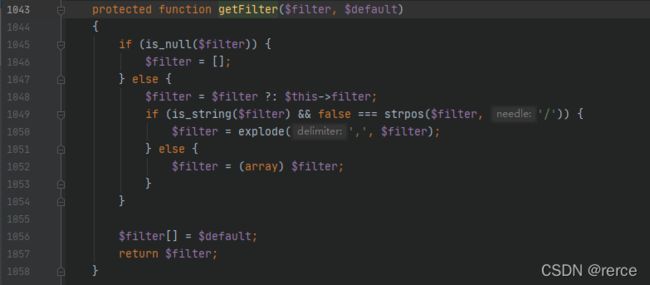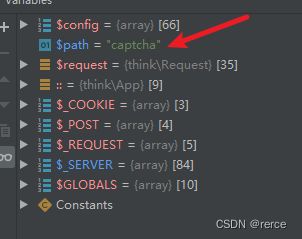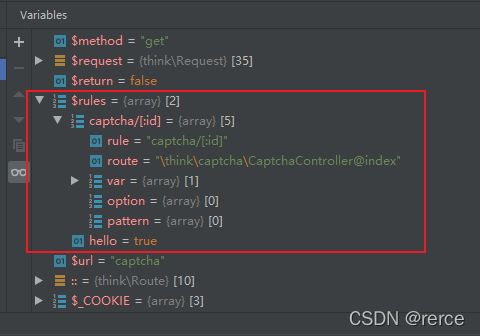Thinkphp 5.0.24变量覆盖漏洞导致RCE分析
大概思路就是我们可以修改requests类的filter属性、method属性以及get属性的值,从而在调用param方法时,call_user_func_array的值我们就可以控制,造成了远程代码执行漏洞。
0. 大致流程
经过入口文件进入run函数
首先在116行根据url获取调度信息时,触发变量覆盖漏洞从而修改requests对象的属性值,然后获取?s=captcha的调度信息并返回给$dispatch
再到139行进入exec函数并将$dispatch作为参数带入
跟进后根据$dispatch的type进入到case ‘method’,从而调用requests的param函数,进而造成了rce漏洞
1.环境搭建
这里用的环境是thinkphp5.0.20+php5.6.27+apache+phpstorm
POC:
复现成功
1.1 POC参数解析
method=get 因为captcha的路由规则是get方式下的,所以我们得让method为get,才能获取到captcha的路由
s=captcha 因为在进入exec函数后我们要switch到method中执行param函数,而这个captcha的路由刚好对应类型为method,所以我们选择captcha
filter[]=system 覆盖变量
get[]=whoami 覆盖变量
_method=__construct 为了能够进入construct,从而覆盖变量
2.漏洞分析
这是一个变量覆盖漏洞导致的rce,我们首先来说下变量覆盖漏洞
2.1 变量覆盖漏洞
漏洞触发点在thinkphp/library/think/Request.php的509行:
这里509行的$this->method我们可控,该值就来自与上一行的$_POST[Config::get(‘var_method’)],其中Config::get(‘var_method’)的值是_method
我们post传入_method为__construct,就会调用request对象的构造函数,参数为post内容
跟进__construct,可以看到他将传入的参数依次赋值给相应的属性,这就造成了变量覆盖漏洞,我们可以随便给requests对象的属性赋值,这为后面的rce打下基础。从poc也能看出来,为了能够rce,这里我们需要修改的属性值有filter,get,method,_method
2.2 远程代码执行
RCE的触发点在thinkphp/library/think/Request.php的param函数:
第一个if是获取post的提交内容并赋值给$vars
然后再整合一下赋值给requests对象的param属性
最后调用该类下的input方法,跟进input方法,$data的值为上图红框
public function input($data = [], $name = '', $default = null, $filter = '')
{
if (false === $name) {
// 获取原始数据
return $data;
}
$name = (string) $name;
if ('' != $name) {
// 解析name
if (strpos($name, '/')) {
list($name, $type) = explode('/', $name);
} else {
$type = 's';
}
// 按.拆分成多维数组进行判断
foreach (explode('.', $name) as $val) {
if (isset($data[$val])) {
$data = $data[$val];
} else {
// 无输入数据,返回默认值
return $default;
}
}
if (is_object($data)) {
return $data;
}
}
// 解析过滤器
$filter = $this->getFilter($filter, $default);
if (is_array($data)) {
array_walk_recursive($data, [$this, 'filterValue'], $filter);
reset($data);
} else {
$this->filterValue($data, $name, $filter);
}
if (isset($type) && $data !== $default) {
// 强制类型转换
$this->typeCast($data, $type);
}
return $data;
}
执行到这一行:$filter = $this->getFilter($filter, $default);
跟进,看代码意思就是将$this->filter的值赋给$filter变量并返回,这个$this->filter是我们可控的即[“system”]
回到input函数,这时候$filter为[“system”]
往下走,$data确实是数组,所以进入if
走到array_walk_recursive($data, [$this, ‘filterValue’], $filter);
array_walk_recursive这个函数大概意思是每次从data中取一个值(第一次的取值由上面图红框可知是whoami),应用于第二个参数所指示的函数
跟进到filterValue方法,看到此时$filter为"system",$value为whoami,走到1073行即可执行我们设置的回调函数并将结果赋值给value
最终返回给我们value值,这就造成任意代码执行漏洞
这就是因为我们覆盖了requests对象的属性值导致的rce漏洞
3.具体流程
当我们执行poc后,从入口函数开始分析
首先加载框架的引导文件
往下走,首先加载基础文件。
然后执行app类的run函数
public static function run(Request $request = null)
{
$request = is_null($request) ? Request::instance() : $request;
try {
$config = self::initCommon();
// 模块/控制器绑定
if (defined('BIND_MODULE')) {
BIND_MODULE && Route::bind(BIND_MODULE);
} elseif ($config['auto_bind_module']) {
// 入口自动绑定
$name = pathinfo($request->baseFile(), PATHINFO_FILENAME);
if ($name && 'index' != $name && is_dir(APP_PATH . $name)) {
Route::bind($name);
}
}
$request->filter($config['default_filter']);
// 默认语言
Lang::range($config['default_lang']);
// 开启多语言机制 检测当前语言
$config['lang_switch_on'] && Lang::detect();
$request->langset(Lang::range());
// 加载系统语言包
Lang::load([
THINK_PATH . 'lang' . DS . $request->langset() . EXT,
APP_PATH . 'lang' . DS . $request->langset() . EXT,
]);
// 监听 app_dispatch
Hook::listen('app_dispatch', self::$dispatch);
// 获取应用调度信息
$dispatch = self::$dispatch;
// 未设置调度信息则进行 URL 路由检测
if (empty($dispatch)) {
$dispatch = self::routeCheck($request, $config);
}
// 记录当前调度信息
$request->dispatch($dispatch);
// 记录路由和请求信息
if (self::$debug) {
Log::record('[ ROUTE ] ' . var_export($dispatch, true), 'info');
Log::record('[ HEADER ] ' . var_export($request->header(), true), 'info');
Log::record('[ PARAM ] ' . var_export($request->param(), true), 'info');
}
// 监听 app_begin
Hook::listen('app_begin', $dispatch);
// 请求缓存检查
$request->cache(
$config['request_cache'],
$config['request_cache_expire'],
$config['request_cache_except']
);
$data = self::exec($dispatch, $config);
} catch (HttpResponseException $exception) {
$data = $exception->getResponse();
}
// 清空类的实例化
Loader::clearInstance();
// 输出数据到客户端
if ($data instanceof Response) {
$response = $data;
} elseif (!is_null($data)) {
// 默认自动识别响应输出类型
$type = $request->isAjax() ?
Config::get('default_ajax_return') :
Config::get('default_return_type');
$response = Response::create($data, $type);
} else {
$response = Response::create();
}
// 监听 app_end
Hook::listen('app_end', $response);
return $response;
}
首先实例化一个requests对象,这个包含了请求的相关信息
往下走到115行,因为我们并没有调度信息,则进入routeCheck函数进行url路由检测产生该url的调度信息,这个调度信息就是匹配?s=captcha对应的路由和类型值供后面的exec函数使用
进入函数,首先将url传给$path
然后设置分割符,到643行进行路由检测,根据定义好的路由返回对应的url调度信息
进入check函数,走到848行,注意这里就是我们触发变量覆盖漏洞的点
进入method函数,接下来就是最上面讲的变量覆盖了,这里就不在多赘述
这个函数执行完会返回我们设置的$this->method即GET,注意这里设置为get是为了获取到s=captcha的路由规则
返回到check函数,跟进到863行,这里给$item赋值
然后检查是否存在$item的路由规则,我们先看一下路由规则里面都有啥,就只有一个当访问captcha/[:id]时路由为\think\captcha\CaptchaController@index
这个路由规则是在vendor\topthink\think-captcha\src\helper.php定义的,这也就是为啥我们将method设置为get,因为只有这样才能获得captcha的路由规则
好了,回到正题,继续跟进到877行,开始路由规则以及类型匹配!!!!!!!!
进入checkRoute函数后走到955行,调用checkRule
走到1194行调用parseRule函数,注意看此时$route参数为\think\captcha\CaptchaController@index已经匹配到路由
进入这个函数看看要干嘛,这个函数太长了,直接看精华部分,根据route的取值我们进入红框分支,在这个分支中,\$result的’type’键对应的值为‘method’。然后将$result层层返回到run函数中,并赋值给了$dispatch。
返回到最开始的run函数,可以看到$result已经包含了captcha的调度信息
继续往下走,因为我们没开debug模式所以123行直接跳过,如果我们开启了debug模式,则直接在126行就可以进入到param函数执行rce
走到139行,带着调度信息进入exec函数
exec函数,因为我们的$dispatch[‘type’]为method,所以进入case ‘method’
protected static function exec($dispatch, $config)
{
switch ($dispatch['type']) {
case 'redirect': // 重定向跳转
$data = Response::create($dispatch['url'], 'redirect')
->code($dispatch['status']);
break;
case 'module': // 模块/控制器/操作
$data = self::module(
$dispatch['module'],
$config,
isset($dispatch['convert']) ? $dispatch['convert'] : null
);
break;
case 'controller': // 执行控制器操作
$vars = array_merge(Request::instance()->param(), $dispatch['var']);
$data = Loader::action(
$dispatch['controller'],
$vars,
$config['url_controller_layer'],
$config['controller_suffix']
);
break;
case 'method': // 回调方法
$vars = array_merge(Request::instance()->param(), $dispatch['var']);
$data = self::invokeMethod($dispatch['method'], $vars);
break;
case 'function': // 闭包
$data = self::invokeFunction($dispatch['function']);
break;
case 'response': // Response 实例
$data = $dispatch['response'];
break;
default:
throw new \InvalidArgumentException('dispatch type not support');
}
return $data;
}
进入requests的param函数
然后就是之前2.2节分析的rce流程了,不再赘述。
4.参考链接
https://paper.seebug.org/787/
https://www.freebuf.com/vuls/307413.html
https://xz.aliyun.com/t/8143#toc-6
https://www.kancloud.cn/zmwtp/tp5/119426






























